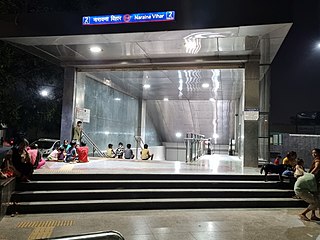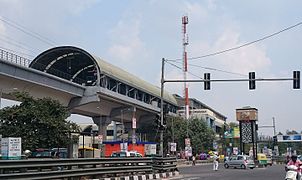
The Red Line is a rapid transit metro line of the Delhi Metro in Delhi, India. It is mostly an elevated line and has 29 stations that runs from Rithala to Shaheed Sthal with a total distance of 34.55 km. The Tis Hazari – Shahdara section of this line was the first stretch of the Delhi Metro that was constructed and commissioned. The line connects the areas of Ghaziabad in Uttar Pradesh and the districts of Shahdara, Central Delhi and North West Delhi in Delhi.

The Yellow Line is a rapid transit metro line of the Delhi Metro in Delhi, India. It consists of 37 stations from Samaypur Badli in Delhi to Millennium City Centre in the neighbouring city of Gurgaon in Haryana. The 49.02 kilometers (30.46 mi) line is mostly underground and laid under one of the most congested parts of Delhi. The Yellow Line is the second line of Delhi Metro to become operational after the Red Line.

Chhatarpur Temple is a Hindu temple dedicated to the goddess Katyayani. The entire complex of the temple is spread over a wide area of 28 hectares. It is located in Chhatarpur, on the southwestern outskirts of the New Delhi. It is the 2nd largest temple in Delhi, after the Akshardham Temple. This temple is constructed from marble and on all of the facets there is jaali work. It can be classified a vesara style of architecture.

The Millennium City Centre Gurugram, branded as SBI Millennium City Centre Gurugram, is a terminal station on the Yellow Line of the Delhi Metro. It is an elevated station and is located in Gurgaon in the National Capital Region of India. The station was inaugurated on 21 June 2010 as part of the Qutab Minar—HUDA City Centre corridor.

The Hauz Khas metro station is an interchange station between the Yellow Line and the Magenta Line of the Delhi Metro. It serves Hauz Khas Enclave, Sarvapriya Vihar, Vijay Mandal Enclave, RBI colony, Mayfair Gardens and the IIT Delhi. The entrance to the station is located on Outer Ring Road, to the east of Aurobindo Marg and to the west of Khelgaon Marg.

Qutab Minar is an elevated station on the Yellow Line of the Delhi Metro. It was inaugurated on 21 June 2010 as part of the 14.47 km completely elevated corridor from Qutab Minar – HUDA City Centre.

Jasola Apollo is a Delhi Metro station in Delhi. It is located between Harkesh Nagar Okhla and Sarita Vihar stations on the Violet Line.

Kaushambi is an elevated metro station located on the branch line of the Blue Line of the Delhi Metro in Delhi. Built as part of a 2.57 km extension from Anand Vihar station, it was originally expected to open in March 2011. After multiple delays, the station finally opened on 14 July 2011, with 200 parking spaces to cater to commuters in the vicinity.

The Delhi Metro is a rapid transit system that serves Delhi and the adjoining satellite cities of Ghaziabad, Faridabad, Gurugram, Noida, Bahadurgarh, and Ballabhgarh in the National Capital Region of India. The system consists of 10 colour-coded lines serving 289 stations, with a total length of 394 kilometres (245 mi). It is India's largest and busiest metro rail system and the second-oldest, after the Kolkata Metro. The metro has a mix of underground, at-grade, and elevated stations using broad-gauge and standard-gauge tracks. The metro makes over 4,300 trips daily.

Kishangarh is an Urban village. The Village is located near Vasant Kunj in South West Delhi district of Delhi, India, on the hills of Aravali, between Mehrauli and Vasant Kunj. One extreme of Kishangarh is around 4 km from Qutub Minar in historic Mehrauli area. The other extreme is approximately 7.5 km from the Indira Gandhi International Airport. Munirka is about 5 km, where the Aruna Asaf Ali Marg, connecting the main Vasant Kunj Marg with the Outer Ring Road forms its western boundary.

The Pink Line is a metro rail line of the Delhi Metro, a rapid transit system in Delhi, India. It consists of 38 metro stations from Majlis Park to Shiv Vihar, both in North Delhi.

Faridabad Sector 28 Metro station is an elevated station on the Violet Line of the Delhi Metro. It is located in Faridabad, Haryana. It is between Mewla Maharajpur and Badkhal Mor station on the line from 6.

The Dashrathpuri metro station opened on 29 May 2018 for public on the Magenta Line of the Delhi Metro. Dashrath Puri is part of Phase III of Delhi Metro.

The Sadar Bazar Cantonment metro station is located on the Magenta Line of the Delhi Metro. It was opened to public on 29 May 2018. Like Shankar Vihar, only military personnel can alight at this station and have to have their ID's as this station also falls under Delhi Cantonment.

The Shankar Vihar metro station is a stop on the Magenta Line of the Delhi Metro. This represents part of the third phase of development of the Delhi Metro. It was opened to public on 29 May 2018. It is the only station in the Delhi Metro network where free movement of civilians is restricted, as it falls in the Delhi Cantonment area and "right in heart of defence zone".

The Sukhdev Vihar metro station is newly opened located on the Magenta Line of the Delhi Metro and situated at Sukhdev Vihar.

The Okhla Vihar metro station is located on the Magenta Line of the Delhi Metro. It is located in Abul Fazal Enclave just behind Jamia Nagar Police station. This Metro station has three gates. One named as Abul Fazal Enclave Part-I another Hari Kothi Road and the last one as Jamia Nagar Police Station.

The Kalindi Kunj metro station is located near Toll booth and is located on the Magenta Line of the Delhi Metro.

The Naraina Vihar metro station is an underground station on the Pink Line of Delhi Metro. A part of Phase 3, it serves Naraina Vihar, Naraina Village and the industrial areas of Shadipur and Loha Mandi along with parts of Mayapuri, and was opened to the public on 14 March 2018.
The Golden Line(Line 10 & Line 11) is an under-construction rapid transit line of the Delhi Metro. It will connect southern Delhi directly with Indira Gandhi International Airport to relieve the increasing traffic, congestion and pollution on roads. It will start from Terminal 1-IGI Airport, which was previously planned from Delhi Aerocity, and end in Tughlakabad. It will be 25.82 km (16.04 mi) long with 16 stations, out of which four will be elevated and 12 will be underground. Construction began on the line in June 2022, as part of the fourth phase of the Delhi Metro's development, and is expected to be completed by March 2027.
























